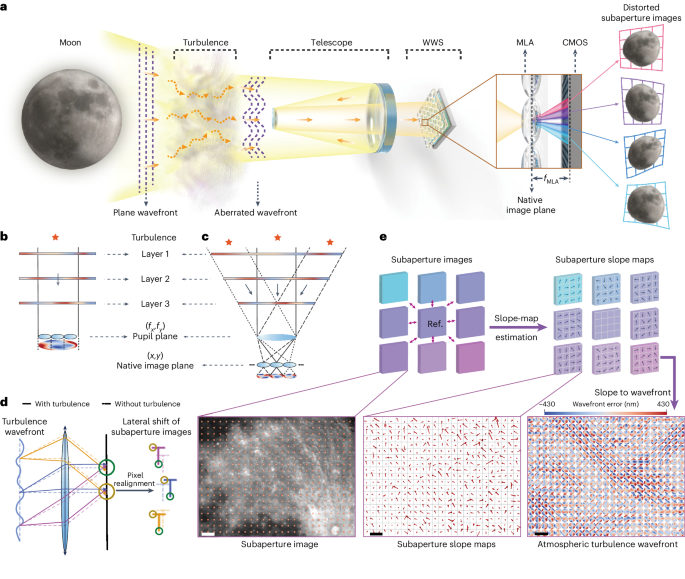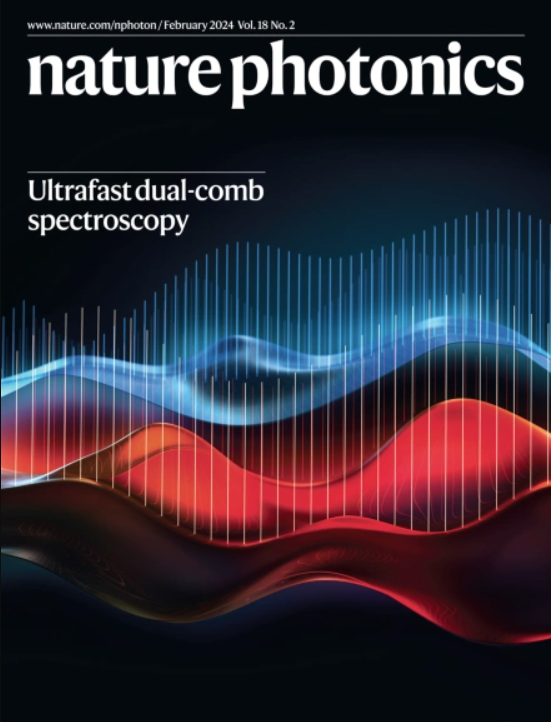利用视频速率宽视场波前传感器直接观测大气湍流
IF 32.3
1区 物理与天体物理
Q1 OPTICS
引用次数: 0
摘要
湍流是一种复杂而混乱的流体运动状态。地球大气层中的湍流由于其在时间和空间尺度上的快速演变,给遥感、自由空间光通信和天文观测等应用带来了根本性的挑战。由于湍流的透明度和各向异性,研究大气湍流的传统方法在捕捉湍流的宽场分布方面面临障碍。在这里,我们开发了一种基于光场的即插即用宽场波前传感器(WWS),有助于以 30 Hz 的频率直接观测 1,100 弧秒的大气湍流。实验测量结果与 von Kármán 湍流模型一致,并通过差分图像运动监测器进一步验证。我们的 WWS 安装在一台 80 厘米望远镜上,能够对 750 米高度以下的三层大气进行清晰的湍流剖面测量,并在不增加可变形反射镜的情况下进行高分辨率像差校正成像。WWS 还能利用卷积递归神经网络和宽场测量,在 33 毫秒内预测湍流动态的演变,从而在自由空间光通信过程中对湍流引起的误差进行更精确的预补偿。动态湍流波面的宽场传感为在大气光学的广阔领域研究湍流的演变提供了新的机会。本文章由计算机程序翻译,如有差异,请以英文原文为准。


Direct observation of atmospheric turbulence with a video-rate wide-field wavefront sensor
Turbulence is a complex and chaotic state of fluid motion. Atmospheric turbulence within the Earth’s atmosphere poses fundamental challenges for applications such as remote sensing, free-space optical communications and astronomical observation due to its rapid evolution across temporal and spatial scales. Conventional methods for studying atmospheric turbulence face hurdles in capturing the wide-field distribution of turbulence due to its transparency and anisoplanatism. Here we develop a light-field-based plug-and-play wide-field wavefront sensor (WWS), facilitating the direct observation of atmospheric turbulence over 1,100 arcsec at 30 Hz. The experimental measurements agreed with the von Kármán turbulence model, further verified using a differential image motion monitor. Attached to an 80 cm telescope, our WWS enables clear turbulence profiling of three layers below an altitude of 750 m and high-resolution aberration-corrected imaging without additional deformable mirrors. The WWS also enables prediction of the evolution of turbulence dynamics within 33 ms using a convolutional recurrent neural network with wide-field measurements, leading to more accurate pre-compensation of turbulence-induced errors during free-space optical communication. Wide-field sensing of dynamic turbulence wavefronts provides new opportunities for studying the evolution of turbulence in the broad field of atmospheric optics. A wide-field wavefront sensor consisting of a microlens array on the native image plane enables observation of atmospheric turbulence over a field of view of 1,100 arcsec at 30 Hz with an 80 cm telescope. With the aid of a neural network, turbulence can be predicted 33 ms in advance.
求助全文
通过发布文献求助,成功后即可免费获取论文全文。
去求助
来源期刊

Nature Photonics
物理-光学
CiteScore
54.20
自引率
1.70%
发文量
158
审稿时长
12 months
期刊介绍:
Nature Photonics is a monthly journal dedicated to the scientific study and application of light, known as Photonics. It publishes top-quality, peer-reviewed research across all areas of light generation, manipulation, and detection.
The journal encompasses research into the fundamental properties of light and its interactions with matter, as well as the latest developments in optoelectronic devices and emerging photonics applications. Topics covered include lasers, LEDs, imaging, detectors, optoelectronic devices, quantum optics, biophotonics, optical data storage, spectroscopy, fiber optics, solar energy, displays, terahertz technology, nonlinear optics, plasmonics, nanophotonics, and X-rays.
In addition to research papers and review articles summarizing scientific findings in optoelectronics, Nature Photonics also features News and Views pieces and research highlights. It uniquely includes articles on the business aspects of the industry, such as technology commercialization and market analysis, offering a comprehensive perspective on the field.
 求助内容:
求助内容: 应助结果提醒方式:
应助结果提醒方式:


